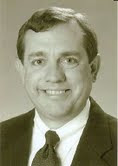And from JustOneMinute which takes longer than a minute but is simple actually:
"The Earnest Prof has an unsolved arithmetic problem; perhaps we can help him with it.
...if we take into account realistic estimates of the fees that mutual funds will charge - remember, in Britain those fees reduce workers' nest eggs by 20 to 30 percent - privatization turns into a lose-lose proposition."
"Hmm, since my beer is cold, I know I am not in Britain, so what might a realistic estimate of cumulative fund fees be here in the States? "
"The CBO, in their July 2004 evaluation, assumed account fees of 0.30% per annum on total assets, which seems plausible for the types of comparable funds run by the Federal Thrift Savings Plan. Shall we try a simple calculation to help the Prof?
Suppose we are 20 years old, and our annual contribution will be an even $1,000 for the next 45 years. Let's keep this real simple, and assume we put the first $1,000 in a no-interest checking account with a 0.30% annual fee. This means that my first $1,000 will be charged $3 in the first year. If I had a spreadsheet (I will in a minute) I would reduce the $1,000 balance by that amount and calculate a new, slightly smaller fee for the second year. But for purposes of this estimation, lets just reduce my $1,000 deposit by $3 each year for 45 years. In that case, the total fees charged on my first $1,000 deposit are ($3 x 45) = $135. That is 13.5% of my initial deposit. But wait! I will also make deposits in subsequent years, and none of them will be charged fees over a full 45 year term. Good point. The last deposit will be charged a fee for just one year; taking a quick average of 45 years and 1 year, we can estimate that the average term is 23 years. The average fee is then $3 x 23, or $69. This is roughly 7% of my $1,000 deposit. Seems too easy, doesn't it? Well, with a modest spreadsheet, we can vary the growth rate in the annual deposit, and plug in an annual return on the account balance. Both of these factors make the account balance, and hence the annual fee, get larger. For 0% deposit growth and a 0% account return, the ending ratio, after 45 years, of an account with a 0.30% fee can be compared to a no-fee account."
"The result is a bit lower than our 7% estimate, coming in at 6.3%. For an account with 5% annual deposit growth (that would represent rising wages), and a 15% account return (that would be an astonishing stock market run), the expenses consume 8.5% of the 'no-fee' account. So the 'right' answer is somewhere in the 6% to 8% range. But hold on! Didn't Paul Krugman just ask for a 'reasonable' estimate, and throw out 20% to 30% in Britain as a comparison? Based on the CBO number and some mental math, we came to 7%, which was quickly confirmed by a more elaborate calculation.
Why, oh why is Prof. Krugman off by a factor of 300% to 400%? How can it be that he is misrepresenting the intelligence and hyping his case? You've got me. Possible answers might include: (a) this was too complicated a calculation for a prospective Nobel Laureate; (b) this was an easy calculation but not a helpful result for polemical purposes; or (c) his beer was warm, and all the folks in Princeton speak English, so he thought he was in Britain.
Enjoy the weekend - pick (a), and put yourself up for a Nobel Prize."
Sunday, January 23, 2005
Subscribe to:
Post Comments (Atom)








No comments:
Post a Comment